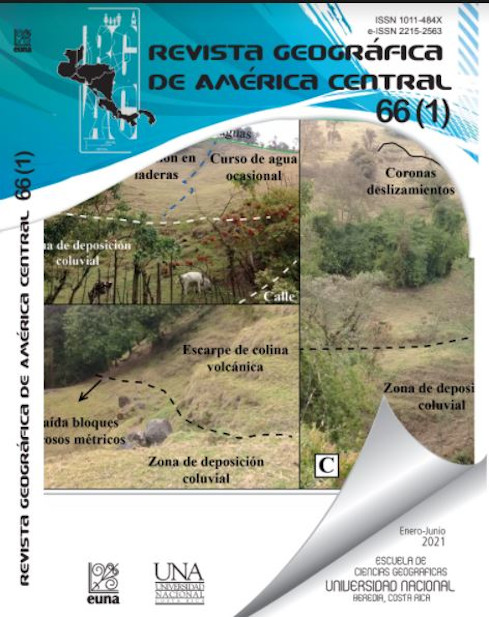Situation of Territorial Information Systems usage for municipal management: case of the Greater Metropolitan Area (GMA), Costa Rica, 2018
DOI:
https://doi.org/10.15359/rgac.66-1.3Keywords:
M-GIS, GIS, TIS, Municipality, Territorial Regulatory Plan, Territorial Planning, Greater Metropolitan Area (GMA; GAM in Spanish), Plan GAM 82Abstract
When referring to Municipal Geographic Information Systems (GIS) the underlying principle remains unaltered as that in Corporate GIS, namely: a system that has been designed to meet multiple objectives within different departments of the same organization. For M-GISs to be successful it is important for the organization to plan in advance the scope and expected results sought by their implementation based on realistic objectives. The present article exposes the current status prevailing in the 31 municipalities that comprise the Greater Metropolitan Area of Costa Rica (locally known as Gran Area Metropolitana (GAM)), regarding the degree of progress in the development of Territorial Information Systems (TIS) as management tools for the execution of different municipal processes and how it has been possible, or not, to feed institutional relevant information, of geographical and non-geographical nature, into M-GISs; the presented situational data stems from a survey carried out between May and October, 2018. For this study, the geographical delimitation is that established in the Regional Urban Development Plan of 1982 (Plan GAM 82) even though it is fully recognized that it has undergone multiple unofficial modifications and reform proposals since its enactment in 1982. Plan GAM 82 remains as a consultation document and is even utilized as an instrument for territorial planning by municipalities that lack or possess a partially approved territorial regulatory plan.
SIG, SIT, Municipalidad, Plan Regulador, Ordenamiento Territorial, GAM, Plan GAM 82.
References
Dirección de Urbanismo (INVU). (s.f). Plan de Ordenamiento Territorial de la Gran Área Metropolitana 2011 – 2030, pp. 1 - 146.
Lara, F. (15 de julio de 2019). Mitad de propiedades carecen de limites oficiales. LA NACION. (p. 6)
INEC. (2011). Costa Rica 2020: Población total proyectada al 30 de junio por grupos de edades, según provincia, cantón, distrito y sexo. Recuperado de: http://inec.cr/poblacion/estimaciones-y-proyecciones-de-poblacion
INVU. (s.f). Manual de Planes Reguladores como Instrumentos de Ordenamiento Territorial, pp. 1-60.
Oficina de Comunicación y Mercadeo, TEC. (abril/junio de 2015). Cartago una ciudad digital. PENSIS, 52-53. Recuperado de: https://repositoriotec.tec.ac.cr/handle/2238/6834?locale-attribute=en
Reglamento 3332. (1982). La Gaceta 119 - 22 de junio de 1982.
Tomlinson, R. (2007). Pensando en el SIG: Planificación del Sistema de Información Geográfica Dirigida a Gerentes. Tercera Edición: ESRI PRESS.
Villalobos, G. (2009). Experiencia Municipal en el Uso e Implementación de un Sistema de Información Territorial. En: Revista Geográfica de América Central 43, 37-47.
Downloads
Published
How to Cite
Issue
Section
License
Proposed policy for journals offering Open Access
Authors publishing their works in the Journal acknowledge and agree to the following terms:
a) Authors retain the copyrights to their works and guarantee the Journal the right to be the first to publish their works, under the Creative Commons License Attribution-NonCommercial-ShareAlike 4.0 International, CC BY-NC-SA 4.0 International (https://creativecommons.org/licenses/by-nc-sa/4.0/deed.es), which allows others to share works upon complying with the acknowledgment of authorship and mention of the Journal as the original publisher of the work.
b) Authors are permitted to separately establish additional agreements for the non-exclusive distribution of the official edition of the work published in the Journal (for example, authors may desire to place the work in an institutional repository or incorporate it into a book that is to published elsewhere) so long they acknowledgment to recognize the Journal as the original publisher. The aforementioned additional agreements must respect the terms of the non-profit character and sharing philosophy of the original license (CC BY-NC-SA 4.0 International, https://creativecommons.org/licenses/by-nc-sa/4.0/deed.es).
c) Authors are encouraged to archive the post-print or editor/PDF version in Open Access repositories.






 REVGEO is licensed under https://creativecommons.org/licenses/by-nc-sa/4.0/deed.es
REVGEO is licensed under https://creativecommons.org/licenses/by-nc-sa/4.0/deed.es
.svg_4.png)

_(1).png)
_(1)_(1)_(1)_1.png)
(2)(1)(1)(1).png)
